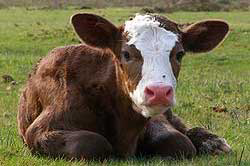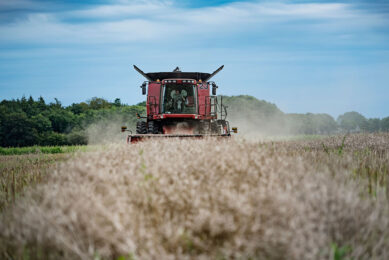Oil Palm leftovers, alternative food for livestock

Oil palm is known for many things. Cooking oils, cosmetics, oleochemicals and biodiesels are what most people will come up with, if you ask them how the crop is used after harvesting. Save for people in the industry, few are aware how much value there is in oil palm waste.
Fruit from the oil palm tree has an oily outer layer and a single seed within, both of which contain commercially valuable oil. About 98.8% of the value in oil palm comes from oil products, including palm oil, oleochemicals, palm kernel oil, finished products and biodiesel. The remaining 1.2% of the value found in the plant’s by-products however, are not to be scoffed at.
One by-product of the industry is palm kernel meal. This is the pulpy mass left over after oil has been extracted from palm kernel seeds. Every year, over seven million tonnes of the stuff is dried and processed, ending up as feed stock for cattle, mostly in New Zealand and Europe. The biggest importer is the European Union, which took in about 2.63 million tonnes in 2013, followed by New Zealand with 1.52 million tonnes. The Malaysian Palm Oil Council (MPOC) explains that this substance is packed with minerals, protein, fat and carbohydrates.
Cattle, which have four chambered stomachs, are particularly suited to the meal due to their ability to digest its high starch, sugar and cellulose content. In monogastric animals such as the African catfish or layer chickens, palm kernel meal can be used to make up about 20% to 30% of the animal’s diet. In beef cattle, palm kernel meal can constitute up to 80% of the diet and for dairy cattle, 50%. This makes the dairy industry a big customer of Malaysia’s palm kernel meal.
One of the largest importers is New Zealand which accounts for about a third of global milk exports. In 2013, the country which is home to more cows than it is to people, shipped in about 1.52 million tonnes of palm kernel meal. Palm kernel meal is an important source of supplementary stock feed to grass and hay for dairy cattle, especially in drought-affected areas. As a country that is hugely reliant on its dairy industry, New Zealand places biosecurity as a top priority.
In response to such concerns, risk assessments conducted by its Ministry of Primary Industries have shown that palm kernel expeller (a term used interchangeably with palm kernel meal) is not a natural host for potentially worrying pathogens, such as the foot and mouth disease virus. Besides, import conditions require each consignment to be heat processed to 85°C and stored in factories dedicated to the processing of palm fruits and kernels, and kept clean and free of potential contamination following production.
The ministry has also ensured that under the Import Health Standard, palm kernel meal will only be imported from approved and audited facilities. These assurances can only be a good thing for responsible exporters based in Malaysia and Indonesia, which together, accounted for about 90% of world exports in 2013 (Malaysia, 2.58 million tonnes and Indonesia, 3.56 million tonnes).
In Malaysia, most palm kernel meal is exported as its dairy and cattle industry is relatively small, with the local consumption at 23,000 tonnes last year. Just recently, a memorandum of undertanding was signed, which will secure Pakistan as an importer of palm kernel meal from Malaysia.
Plantation Industries and Commodities Minister Datuk Amar Douglas Uggah Embas witnessed the signing, which designates Chapri Group as the main agent to distribute palm-based animal feed from local supplier Erafeed. According to the MPOC, recent market prices have allowed palm kernel meal to offer the best value for money in animal feed ingredients. Based on market price trades in Rotterdam in August 2013, the total digestible nutrient per US dollar is higher than soybean, rapeseed, and sunflower meals. “In other words, one US dollar spent on palm kernel meal gives feed millers an energy value of 52.7 megajoules, which is 29% to 108% higher than that of soybean, rapeseed and sunflower meals,” says the MPOC. “Of course, that is due to its high fibre content. You would need to feed a lot more (palm kernel meal) in order to deliver the same amount of nutrients.”
On the whole, countries like New Zealand encourage the use of locally grown feed where practicable. However, climatic events may impact availability of local stock feeds, which is where palm kernel meal often ends up being a valued supplement. A few years ago for example, a major drought disrupted normal self-sufficiency in New Zealand and palm kernel meal helped fill the void.
Source: The Star
Join 26,000+ subscribers
Subscribe to our newsletter to stay updated about all the need-to-know content in the feed sector, three times a week. Beheer
Beheer









 WP Admin
WP Admin  Bewerk bericht
Bewerk bericht